I started watching this video series on a DIY lab power supply by Dave @ EEVBlog. On his video he's analyzing mostly simple constant current circuit. However, at the top of the circuit there's two transistors in the op-amp feedback. He explains fairly well how the circuit works, but I'm unsure (I have my suspicions) why there are two transistors as opposed to one.
-
I don't think it's a long tailed pair. – Paul Mar 21 '12 at 02:28
-
I figured out that it was a darlington transistor pair. I think Dave mentioned it in the video but I failed to realize it. After analyzing the transistors on their own, it definitely makes sense. – Paul Mar 21 '12 at 02:47
-
No. Not a long tailed pair. That was based on his word description. – Russell McMahon Mar 21 '12 at 09:03
1 Answers
To make best use of the resources provided by others it pays to make the effort to include relevant material with your question rather than have people go searching for it. video link is a start but most videos need searching through and all need downloading and people need to find what you are talking about. In this case it was obvious and quickish but if one of you can do the work once rather than expecting 5 or 10 or 20 other people to do the work 5 or 10 or 20 times it helps us all.
A screen shot (Alt-PrtScr in many systems) and paste to a picture editor gives you an uploadable image. Quality may not be marvellous but it's about 30,000% better than no picture at all.
See screen dump picture below.
The arrangement is, as you say, known as a "Darlington pair". The aim is to provide much more current gain than can be had with one transistor.
Current gain overall = Gain_12 = Gain 1 x Gain 2
Typically a transistor will have a Beta (= current gain) of about 100 fo a small signal transistor (can be 50-500+) and say 10-100 for a power transistor (and 1-3 for a few special purpose types. ) So this arrangement may have a Beta of 100 x 100 = 10,000 or perhaps 100 * 10 = 1000. Either way it means the effective power transistor formed by the pair has MUCH more gain than one normal transistor by itself.
(Darlingtons have some special features and disadvantages as well which are not too important here).
Here, using a Darlington pair allows a relatively small opamp output current to control a much larger output current. The feedback from the lower emitter to opamp- ensures that the output tracks Vr. I won't comment on the rest of the circuit.

Good discussion on Darlington and Sziklai {compound} pairs
- 13,748
- 5
- 42
- 72
- 147,325
- 18
- 210
- 386
-
A current gain of 1000 is a lot even for a small signal transistor. Here you need a power transistor, which typically has much less current gain (< 100). – starblue Mar 21 '12 at 07:21
-
@starblue - thanks. 1000 = typo. Should have read 100. Generally updated. – Russell McMahon Mar 21 '12 at 09:12